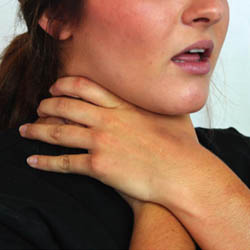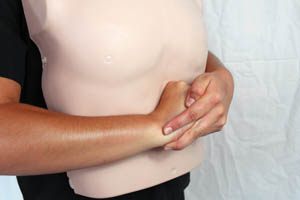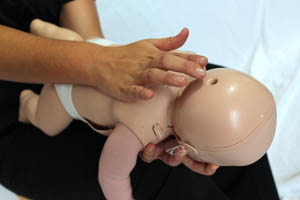Your cart is currently empty!
How Do You Respond When Someone Is Choking: Get CPR Certified!
Each year, more than 5,000 people lose their lives from choking, and the risk disproportionately affects age groups, asserts NSC.org. In 2015, 2,848 of 5,051 people who passed away from choking were above age 74. Proper response by a CPR certified individual is essential to reducing mortality.
Choking is a medical instance where the lines between first aid respond and CPR begin to blur. Individuals that suffer choking from a complete blockage of the airway, as well as a partial blockage that reduces airflow to an extreme, are more likely to lose consciousness and enter cardiac arrest.
According to MedlinePlus, a person, including infants, children, and adults, can suffer permanent brain damage within four minutes of not receiving enough air.
To improve the quality of care and reduce mortality, healthcare professionals, and anyone involved in caring for others, regardless of care setting, need to understand how to respond to choking.
Recognizing the Signs of Choking
The signs of choking are not difficult to miss in adults and children, but very young children, such as toddlers and infants, may be unable to express the common signs of choking.
The universal sign of choking is a person clutching the throat with hands. However, a person in distress may not always exhibit this classic sign. As explained by the MayoClinic.org, additional indicators of choking include:
- Being unable to speak
- Exhibiting distress in breathing or unusually noisy, squeaking. caused by an obstruction in the airway
- Weak or forceful cough
- Flushed appearance, comprised of pallor and subsequent cyanosis (bluish discoloration)
- Blue or dusky discoloration of the skin, lips, and nails
- Loss of consciousness
If choking continues unaddressed, a person will lose consciousness due to a lack of oxygen. This is the area where health care professionals may forget the proper course of action. At this point, responding to choking turns more toward performing CPR than the traditional abdominal thrusts.
Common Ways to Respond to the Choking Victim
Encountering a choking person is an emergency. Ask, “are you choking?” If the person responds vocally, encourage continued coughing. However, someone who is unable to speak, cough, or breathe, requires immediate intervention. Tell the person, “I am going to help you performing abdominal thrusts, placing my hands around your waist.”
Although explaining your actions may seem irrelevant, it is essential to preventing a person from becoming further. This is especially true in children but note that abdominal thrusts are not recommended for children under the age of one.
To perform abdominal thrusts on an adult, follow these steps:
1. Stand behind the victim, and place one leg between the victim’s legs. This position gives the most leverage for performing abdominal thrusts. If the person begins to fall during the process, it also provides support to prevent a person from falling.
2. Reach around the abdomen. taking note of the location of the navel (belly-button).
3. Form a fist with one hand, pressing the thumb side of your fist against the abdomen above the navel. If you have long nails, curl fingers as much as possible. Do not forgo performing further help for fear of hurting the person. The worst thing you can do is to do nothing.
4. Verify that your placement is not located at the position of the xiphoid process, which is the raised cartilaginous extension at the base of the sternum. In general, the xiphoid process is located approximately one-fist-length below the “nipple-line.” However, children may vary in size dramatically, and the xiphoid process is usually more cartilaginous in children. In adults, it is imperative to ensure your fist placement is well-below the xiphoid process. Failure to do so could result in serious medical injury or trauma to the heart or lungs. Therefore, always place hands slightly above the navel.
5. Grasp your fist with the opposing hand. It is almost impossible to perform abdominal thrusts with one hand, so never forgo this step.
6. Press hard into the abdomen, making an upward thrust at the same time. Imagine trying to lift someone up in your arms. Allow for recoil, and repeat abdominal thrusts until the object is dislodged. Depending on the instructing body, like the American Red Cross or the International Liaison Committee on Resuscitation, additional measures for choking first aid may include delivering back blows in adults, alternating five back blows to five abdominal thrusts.
To deliver a back blow, stand just the side of the victim. Place one arm over the person’s chest. Bend the victim forward, forming a 90-degree angle at the hips. Deliver five back blows between the person’s shoulder blades.
If a person who has been choking does not resume breathing after dislodging the blockage, begin standard CPR for the given age group of the person in distress. This reasserts why being CPR certified is key to survival in responding to choking
Choking Victim Special Considerations
In some instances, such as infants, obese individuals, and pregnant women, standard abdominal thrusts may not be possible or result in injury to the person or unborn child. These special circumstances require a modification to the process.
Infant and Small Child Modifications
 For an infant, position is everything. Sit, and position the infant facedown, placing one hand on the infant’s chest. The legs should be pointed toward your elbow. Slightly invest the infant to where the head is lower than the trunk. Deliver five firm thumps, also known as back blows, to the middle of the back with the heel of your hand. Do not use the full width of your hand as it may cause unintentional injury.
For an infant, position is everything. Sit, and position the infant facedown, placing one hand on the infant’s chest. The legs should be pointed toward your elbow. Slightly invest the infant to where the head is lower than the trunk. Deliver five firm thumps, also known as back blows, to the middle of the back with the heel of your hand. Do not use the full width of your hand as it may cause unintentional injury.
Grasping the infant, rotate him to face upward on your forearm. Use two fingers to press 1.5-inches down at the center of the breastbone five times. These compressions are the same method for performing chest compressions on an infant. However, the ratio remains smaller, but the ratio becomes the standard breath to compression ratio if the infant loses consciousness.
Repeat back blows and chest thrusts until the object is dislodged. If the infant does not resume breathing, begin standard infant CPR.
Obese Individuals and Pregnant Women Modifications
For obese or pregnant individuals, move the position of your fist and hands higher than routine abdominal thrusts. This will position the hands at the base of the breastbone, without risking injury to the xiphoid process or an unborn child. This measure is also useful for obese persons as raising the contact point allows a person with smaller arms to perform abdominal thrusts on a larger person.
Key Differences for Choking Response by Age Group
 In children above the age of one, bend at the knees to position your body to deliver abdominal thrusts to a small victim.
In children above the age of one, bend at the knees to position your body to deliver abdominal thrusts to a small victim.
For seniors and those with known bone illnesses, verify placement of the hands prior to administering abdominal thrusts. As an additional measure in providing care to seniors, know the person’s DNR status. If a senior loses consciousness and requires CPR, a DNR (Do Not Resuscitate) order may be in effect. However, you should always err on the side of caution, providing life-saving support, until you have a verified DNR order.
With adults, loss of consciousness, resulting in lack of a pulse, requires CPR and contacting Emergency Medical Services (EMS) or activating the “Code Team” immediately. This is due to being physically unable to move an adult to another area to receive care, provided you have been administering care as an individual. If alone and providing care to an infant or small child, take the child with you to contact EMS.
Never Do a Blind Finger Sweep
Older authoritative organizations advised caregivers to perform a blind finger sweep to attempt to remove an object from a choking victim, regardless of age, says WebMD. This notion has been replaced by evidence-based practices to only perform a finger sweep if you can see the object clearly in the person’s mouth.
Blind finger sweeps may push an object further into the airway. When providing choking first aid, visually check the mouth of the person receiving help between sets of abdominal thrusts or before administering rescue breaths, a key benefit of being CPR certified and providing support for loss of consciousness due to choking.
The Importance of Care After Response
Following a choking experience, it is easy to assume a person is okay. However, any instance of choking, even when consciousness is never lost, could still result in serious medical complications.
For example, aspiration may have occurred, which could lead to the buildup of fluid and bacteria in the lungs. Following any choking instance, see a health care professional for a full evaluation. This is the only way to ensure survival beyond the initial response.
Tips for Preventing Choking in Care Settings
Caregivers can help prevent choking in infants, children, and adults, as well as seniors, by following a few choking safety tips, including:
1. Avoid Giving Small Children Small Toys or Those With Removable Parts That May Become a Choking Hazard
Small toys and those with removable parts are particularly dangerous for infants and toddlers. Among infants, the choking hazard is highest, but it persists through early childhood.
2. Check for Dietary Changes Prior to Mealtime
Failure to recognize dietary changes before providing meals can be a source of the increased choking risk. For example, a person may have a diet changed from “regular” to “mechanically altered.” This is essentially a way of saying ground meats and hard foods, preventing a person from taking large bites. Also, verify the meal served against the prescribed diet. If a person is to be given pureed foods, never give whole, “regular” items.
3. Use Thickened Liquids as Ordered
In the elderly and those with severe illnesses, thickened liquids may be ordered to reduce choking risk. Common consistencies for thickened liquids are “nectar,” meaning a liquid that is thickened slightly more than standard water, “honey” and even “applesauce.” The varying viscosity helps prevent liquids from entering the trachea.
4. Don’t Try to Give a Person Too Much at Once
When assisting with meals, avoid giving a person too much to chew at one time, and never try to “wash down” excess food with liquid. This will only further increase choking risk. Take your time, ensuring a person has swallowed the bolus, the technical term for the food in the mouth after being chewed, before giving another bite. These concerns are most prevalent in care settings requiring a caregiver to help a person eat. In infants, remove the bottle any time the infant appears distressed or is unable to swallow fast enough. It may be necessary to remove the bottle periodically throughout the process, giving the infant an opportunity to rest.
5. Avoid Distractions
Distractions during meals can result in caregivers not noticing the signs of choking. Avoid distractions, like using mobile devices, reading, or watching movies. Obviously, it may not be possible to shut down televisions or other media during meals, as may be the case in skilled nursing facilities, but avoid paying too much attention to these devices. Focus on helping the person in your care enjoy the meal without increasing choking risk.
6. Watch for Changes in Facial Hue
This is among the most important tips. Any changes in facial hue, particularly turning pallor or cyanosis, are a sign of choking and should be treated appropriately.
7. Avoid Using Straws
Although a preference to many, straws may actually increase the risk of choking. Avoid using straws, and if a straw is used, carefully monitor the person using it, especially when giving items that may have large chunks in the drink, such as a smoothie or shake.
8. Avoid Foods That Are Difficult to Chew
Steak and other hard foods should be cut for those in your care with a predisposition to choking, such as being elderly or unable to cut food themselves, to bite-sized portions
9. Check Denture Placement Before Meals
Individuals with partial or full dentures may also have an increased choking risk. Ensure dentures are properly placed with the right sealant or bonding gel before meals.
Being CPR Certified Increases Your Ability to Respond to Choking
No one wants to think about the risk of choking, but it is a very real possibility in any care setting. Know how to recognize the signs, how to respond, and work to prevent choking when possible. Also, become certified to administer life-saving support, including CPR, to ensure you can provide the right type of care for both conscious and unconscious choking victims. Do you have any other tips for preventing choking? Join the conversation by sharing this article on social media today.







Until reading this article, I had no idea that over 5,000 people die from choking each year. This makes me very scared, but makes me aware where I want to learn how to help during these type of emergencies. Thank you for letting me know that knowing CPR will increase the likelihood of someone surviving. I’ll need to find a good place that I can get CPR certified.